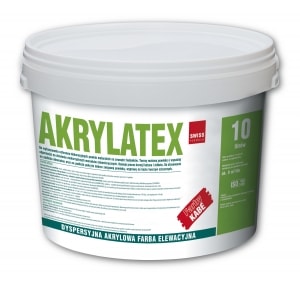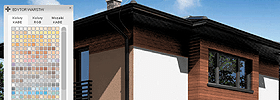AKRYLATEX

Dispersion, acrylic paint for painting concrete elements and pedestals
The dispersion topcoat paint is intended for performing paint coatings outside buldings, including KABE THERM ELASTO and KABE THERM RENO EWI systems based on EPS. It is especially recommended for primary and renovation painting of all concrete and reinforced concrete substrates such as flyovers, industrial halls, office buildings, warehouses, cooling towers, chimneys, asbestos and cement boards, cement and fibre boards, cement roof tiles, concrete fencing as well as cornices and pedestal parts of the buildings. It creates a flexible and tight coating of high resistance to adverse atmospheric conditions (such as precipitation, temperature changes, solar radiation) as well as to soiling process. As it does not absorb water, it stabilizes the moisture content in the external concrete layer. Due to the very low permeability of carbon dioxide (CO2), it inhibits the process of concrete and reinforced concrete carbonization efficiently. It is used
for painting all mineral construction substrates, acrylic top coats, as well as substrates covered with well set and bound polymer-based coats. Absorbent substrates, prior to paint application require priming with BUDOGRUNT ZG.
Note: If a renovation paint coating is performed on old acrylic renders, it is recommended to apply NOVALIT F polysilicate paint due to low surface tension while drying.
| Base binder: | copolymer binder; |
| Pigments: | resistant to UV radiation and atmospheric conditions non-organic and organic coloured pigments; |
| The content of volatile organic compounds VOC: | cat. A/c. The product contains less than 40 g / l VOC; |
| Density: | ca. 1.45 g/cm³; |
| Colours: | white, colours from the KABE colour chart and selected NCS colours or according to samples provided; |
| Gloss level: | matt; |
| Diluent: | water; |
| Average coverage: | ca. 0.22 l/m² (with double painting on a smooth substrate); |
| Temperature of application (air and substrate): | from +5°C to +25°C; |
| Relative humidity: | ≤75%; |
| Relative diffusion resistance of the layer with a thickness of 150 μm: | Sd = 0.9 m (standard requirement Sd ≤ 2.0 m); |
| Relative CO2 diffusion resistance: | Sd = 63.5 m; |
| Surface absorption coefficient: | w = 0.006 kg/m² • h0.5 (standard requirement w ≤ 0.5 kg/m² • h0.5); |
| Packaging: | Single-use plastic packaging of 5 and 10 l; |
| Storage: | The product should be stored in its sealed packaging in a cool, but frost-protected room. Opened packaging should be tightly closed and used as quickly as possible; |
| Shelf life: | Originally sealed products have a 18-month shelf life from the date of production (this is printed on the side of the packaging). |
• Resistance to adverse atmospheric conditions
• Delayed concrete and reinforced concrete corrosion process
• Protection against humidity
• Increased resistance to the substrate alkalinity
• Wide range of colours
• To be applied on both mineral substrates and polymer coated surfaces
SUBSTRATE PREPARATION: Apply to a sound/stable and clean substrate (without cracks and delaminations), degreased, dry, and free of biological contamination or chemical efflorescence. In case of algae/fungi growth, the substrate
should be cleaned mechanically and then wash with water and disinfect with ALGIZID. Any loose layers not bound to the substrate (i.e. loose render or flaked coatings) should be removed. Old and/or dirty substrates should be washed
off and degreased with water and CLEANFORCE cleaning agent. If there is any large unevenness of the substrate (from 5 to 15 mm), use levelling compound and then apply the whole surface with KOMBI HYDRO STOP levelling coat or
KOMBI FINISZ levelling/finish render. Minor unevenness (up to 5 mm) can be levelled out at once and smoothened with KOMBI HYDRO STOP base coat or KOMBI FINISZ levelling/finish render. Absorbent substrates should be primed
with BUDOGRUNT ZG before levelling compound or finish levelling and smoothing compound application. If paint is applied on new mineral substrates (such as concrete, cement render, cement-lime render), 4-week curing period is required. Before applying the paint in the KABE THERM AVANT and KABE THERM ELASTO EWI systems, all coats of the systems must be made in accordance with the technology of the External Thermal Insulation Composite Systems – ETICS. Acrylic paint can be applied to thin coat acrylic render only after 48h of exposure (at + 20 ° C and 65% relative humidity).
PRIMING: Before paint application, the substrate should be primed with BUDOGRUNT ZG. Primer should be dry before applying a paint, curing period lasts about 24 hours. Note: Substrates of low wettability (such as top coats based on polymers or dispersion coatings) should not be primed and should be only washed with water and CLEANFORCE cleaning agent.
PAINT PREPARATION: The packaging contains a ready-to-use product. If required, add a small amount of clean water (by adding to the first painting max. 10% of volume and to the second one max. 5%). Quantity of added water may vary depending on the substrate type, drying conditions and application method.
APPLICATION: Paint should be applied on the substrate in two layers with a brush, roller or by spraying (including also the ‘airless’ method). The second paint layer to be applied only after the first one dries completely, i.e. after min. 3-4 hours. It is recommended to use a special paint roller for facade paints made of woven polyamide with a bristle length of min. 18 mm. Use mechanical spraying only in windless weather.
DRYING: Typical drying time ca. 3 h for one paint layer applied to substrate (20°C, 55% RH). Note: Drying time may be longer due to low temperatures and high relative humidity. Protect the fresh coating against precipitation and condensation until it dries completely.
USEFUL HINTS: To avoid colour differences, a single batch product should be applied to entire facade or element in one working cycle. To be applied on dry days at temperatures between 5-25°C. All tools to be cleaned with water after finishing work. Application during direct exposure to sunlight, in strong winds or high air humidity is not recommended. To protect wet coating against inclement weather conditions, scaffolding should be covered with some protective netting.
ADDITIONAL OPTIONS: If paint is applied on substrates covered with cracks with a width of up to 0.3 mm (such as small shrinking cracks of the top coat), it is recommended to use paint reinforced with microfibres for the first painting (an option available on request). In order to increase the resistance of the coating to the growth of algae and fungi (while renovating EWI systems and while painting facades in shaded places of increased humidity and with a high concentration of plants), it is recommended to add a special protective substance to the paint (additional service).


 AKRYLATEX - TDS
AKRYLATEX - TDS